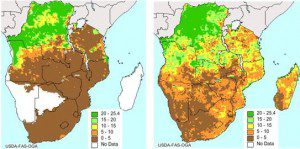
The image on the left portrays soil moisture in southern Africa during mid-April 2014 and is based on rain gauge data only. The more detailed image on the right includes soil moisture data from ESA's SMOS mission that are assimilated into the USDA's FAS forecasting system.
The European Space Agency's Soil Moisture and Ocean Salinity (SMOS) mission has reached beyond its water cycle mission to predict drought and improve crop yield in regions prone to famine.
The U.S. Department of Agriculture (USDA) uses satellite images and soil moisture data to help identify abnormal weather that may affect crop production and yield. Using this information, the department publishes monthly estimates of world production, supply and distribution.
Analysts use information linked to drought from a range of observing systems to compile crop production forecasts. In the past, the amount of moisture in the soil available to plants was estimated by integrating daily observations of rainfall and temperatures into computer models of soil“water balance. However, this approach only works reliably in areas where high-quality observations are available. In large areas of the world, such as southern Africa, there are little or no such data.
Turning to space, the USDA Foreign Agricultural Service started to incorporate data from ESA's SMOS satellite into its forecasting system. Carrying a novel sensor, SMOS captures images of brightness temperature. These images correspond to microwave radiation emitted from Earth's surface and can be related to soil moisture and ocean salinity”two key variables in Earth's water cycle.
Through SMOS, the service obtains timely information on soil moisture patterns, which help to predict how the health of plants will change and, therefore, how productive they will be. Testing the SMOS readings for this purpose, the service received positive feedback from analysts in southern Africa. This is a challenging area because there are few working rain gauges.
Image courtesy of USDA FAS

